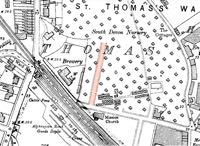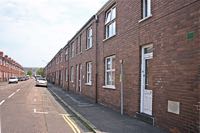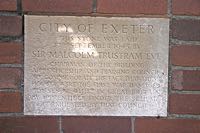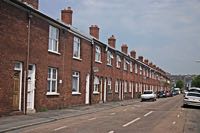
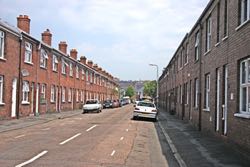 Isca Road
Isca Road
Page updated 5th March 2018
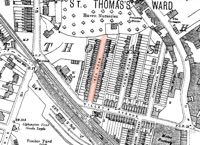 This road was the
first council built estate in
Exeter and dates from 1904 to 1907, on land donated by Henry Willey of
Willeys Foundry. Initially, there wereto be forty two,
red brick, work mens' dwellings with a garden for rent, at a cost of 4
shillings and 9 pence per week (24 pence).
This road was the
first council built estate in
Exeter and dates from 1904 to 1907, on land donated by Henry Willey of
Willeys Foundry. Initially, there wereto be forty two,
red brick, work mens' dwellings with a garden for rent, at a cost of 4
shillings and 9 pence per week (24 pence).
By 1907, 49 Class B houses, accommodating five people had been completed, along with the required sewer pipes. Another nine Class A houses for housing six people were still to be erected. The Local Government Boad had approved borrowing £1,187 to be repaid within 80 years for the land. Another £7,829, to be repaid in 54 years, under the Exeter Corporation Act of 1890 was for the street, sewage and house construction. A further some of £3,494 from the Workmen's Dwellings Act, 1890, was borrowed, to be repaid in 56 years. Isca Road was extended in later years with semi detached houses, until it became a through road, joining Haven Road.
The road is situated off Willey's Avenue near Haven Banks. Isca is from the Roman name for Exeter, Isca Dumnoniorum. The Dumnonii were an ancient British tribe from the area.
A hit and run raid in December 1942 resulted in a bomb hitting the end of Isca Road damaging some houses, and collapsing the church, a 'tin tabernacle' constructed of galvanised iron at the junction with Willeys Avenue, that Henry Willey had also provided in 1904. A fire guard, David Tosh Richardson, was injured in the raid, and died at Heavitree Road on the 13 January 1943.
The church doubled as the boys section of the Comrie High School for Girls and Preparatory School for Boys, while the girls' school was on the corner of Chamberlain Avenue. One former pupil of the school remembers Tommy Cooper attending the school in the 1920s.
Nos 1 to 8 Isca Road were the first bomb damaged houses in Britain to be repaired by a scheme to train apprentices. A wall plaque on No 2 reads:
THIS STONE WAS LAID
27TH SEPTEMBER 1945 BY
SIR MALCOLM TRUSTRAM EVE
CHAIRMAN OF THE
BUILDING APPRENTICESHIP AND
TRAINING COUNCIL
TO COMMEMORATE THE FACT THAT
THESE HOUSES WERE THE FIRST WAR DAMAGED
HOUSES RE-BUILT IN GREAT
BRITAIN BY APPRENTICES UNDER THE SCHEME
FORMULATED BY THAT COUNCIL.
After a Government White Paper in 1943, the BATC (Building Apprenticeship Training Council) was inaugurated with Sir Malcolm Trustram Eve as the chairman. It was intended that as many as 10,000 boys per annum would be supplied to the building industry through the scheme.
In 1914, Isca Road contained no's 1 to 47 on one side and 2 to 50 on the other. It is interesting to go through their professions. There were nine labourers and six brass finishers. Other jobs that reflected the various foundries in the vicinity include, two ironmoulders, a tinman and a motor tester. There were other professions that weren't with the foundry such as two boot and shoe makers, a potter who would have been emplyed by HArt and Moist, the Exeter Pottery in Tan Lane, a gardener and four carters/wagoners. Two inhabitants were probably retired and there were three females, probably widows. All in all, a very working class section of Exeter's population.
│ Top of Page │
